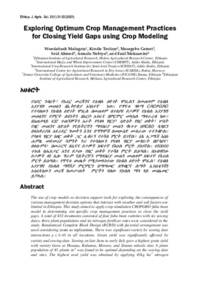Exploring Optimum Crop Management Practices for Closing Yield Gaps using Crop Modeling

Authors:
The use of crop models as decision support tools for exploring the consequences of various management decision options that interact with weather and soil factors are limited in Ethiopia. This study aimed to apply crop simulation CROPGRO-faba bean model in determining site-specific crop management practices to close the yield gaps. A total of 432 treatments consisted of four faba bean varieties with six sowing dates, three plant populations, and six nitrogen fertilizer rates were considered in the study. Randomized Complete Block Design (RCBD) with the factorial arrangement was used considering years as replications. There was significant variety by sowing date interactions in all locations. Grain yield was significantly affected by variety and sowing date. Sowing on late June to early July gave the highest grain yield with variety Gora at Hosana, Kulumsa, Meraro, and Sinana nitisols sites A plant population of 45 plants m-2 was found to be optimal depending on the sowing date and sites. The highest seed yield was obtained by applying 45kg ha-1 nitrogen fertilizer in most of the locations. The result showed the application of crop models in agronomic research, crop improvement, and incorporation of the findings provides important information to prepare extension material and increase production on the existing crop land.
